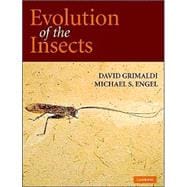
| Section 1. Diversity and Evolution: Introduction | |
| Species: their nature and number | |
| How many species of insects? | |
| Reconstructing evolutionary history | |
| Section 2. Fossil Insects: Insect fossilization | |
| Dating and ages | |
| Major fossil Insect deposits | |
| Section 3. Arthropods and the Origin of Insects: Onychophora: the velvet-worms | |
| Tardigrada: the water-bears | |
| Arthropoda: the jointed animals | |
| Hexapoda: the six-legged arthropods | |
| Section 4. The insects: Morphology of insects | |
| Relationships among the insect orders | |
| Section 5. Earliest insects: Archaeognatha: the bristletails | |
| Zygentoma: the silverfish | |
| † | |
| Rhyniognatha | |
| Section 6. Insects Take to the Skies: Pterygota, Wings, and flight | |
| Ephemeroptera: the mayflies | |
| † | |
| Palaeodictyopterida: extinct beaked insects | |
| Odonatoptera: dragonflies and early relatives | |
| Neoptera | |
| Section 7. The Polyneopterous Orders: Plecopterida | |
| Orthopterida | |
| Plecoptera: the stoneflies | |
| Embiodea: the webspinners | |
| Zoraptera: the Zorapterans | |
| Orthoptera: the grasshoppers, crickets, and kin | |
| Phasmatodea: the stick- and leaf insects | |
| † | |
| Titanoptera: the titanic crawlers | |
| † | |
| Caloneurodea: the Caloneurodeans | |
| Dermaptera: the earwigs | |
| Grylloblattodea: the ice crawlers | |
| Mantophasmatodea: the African rock crawlers | |
| Dictyoptera | |
| Blattodea: the roaches | |
| Citizen roach: the termites | |
| Mantodea: the mantises | |
| Section 8. The Paraneopteran Orders: Psocoptera: the 'bark'lice | |
| Phthiraptera: the true lice | |
| Fringe wings: Thysanoptera (thrips) | |
| The sucking bugs: Hemiptera | |
| Section 9. The Holometabola: problematic fossil orders | |
| The origins of complete metamorphosis | |
| On wings of lace: Neuropterida | |
| Section 10. Coleoptera: early fossils and overview of past diversity | |
| Archostemata | |
| Adephaga | |
| Myxophaga | |
| Polyphaga | |
| Strepsiptera: the enigmatic order | |
| Section 11. Hymenoptera: Ants, Bees, and Other Wasps: The Euhymenoptera and parasitism | |
| Aculeata | |
| Evolution of insect sociality | |
| Section 12. Antliophora: Scorpionflies, Flies, and Fleas: Mecopterida: mecopterans and relatives | |
| Siphonaptera: the fleas | |
| Evolution of ectoparasites and blood-feeders | |
| Diptera: the true flies | |
| Section 13. Amphiesmenoptera: The Caddisflies and Lepidoptera: Trichoptera: the caddisflies | |
| Lepidoptera: the moths and butterflies | |
| Section 14. Insects Become Modern: Cretaceous and Tertiary Periods: The Cretaceous | |
| flowering of the world: the Angiosperm Radiations | |
| Plant sex and insects: insect pollination | |
| Radiations of Phytophagous insects | |
| Austral arthropods: remnants of Gondwana? | |
| Insects, mass extinctions, and the K/T boundary | |
| The tertiary | |
| Mammalian radiations | |
| Pleistocene dispersal and species lifespans | |
| Island faunas | |
| Section 15. Epilogue: Why so many insect species? | |
| The future | |
| Glossary | |
| References | |
| Index. |
The New copy of this book will include any supplemental materials advertised. Please check the title of the book to determine if it should include any access cards, study guides, lab manuals, CDs, etc.
The Used, Rental and eBook copies of this book are not guaranteed to include any supplemental materials. Typically, only the book itself is included. This is true even if the title states it includes any access cards, study guides, lab manuals, CDs, etc.